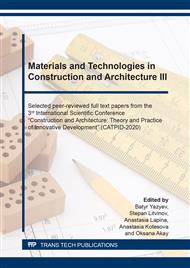p.1
p.8
p.14
p.23
p.31
p.37
p.44
p.52
The Activation Technology for the Surface Modification High Voltage Electric Field Dispersed Mineral Additives for Concrete
Abstract:
The aim of the research was to study the activation technology of the materials for concrete by their surface modification in a high-voltage electric field. It is noted that the mineral additives modified in a high-voltage electric field are characterized by a higher activity of the calcium hydroxide absorption. It was established that, despite the presence of a large number of crystalline compounds in metakaolin, its pozzolanic activity in the absorption of calcium hydroxide from a saturated solution is quite high. The same value of the hydration activity coefficient is also determined for the ground slag. The authors found that a characteristic feature of the dispersed mineral additives, surface-modified in a high-voltage electric field in comparison with control samples, are the lower values of bulk density and repose angle. This is due to a change in the forces balance that occurs during the mutual contact of particles. The influence of the mineral additives’ surface modification in a high-voltage electric field on interparticle interactions in the “solid – liquid” system is evaluated. It is established that in the absence of a repulsion barrier, the particles form the aggregates that increase their sedimentation rate. During unipolar or bipolar charging of particles in an electric field, the sedimentation rate slows down or accelerates accordingly. These effects are used to modify the cement surface.
Info:
Periodical:
Pages:
23-30
Citation:
Online since:
September 2020
Price:
Сopyright:
© 2020 Trans Tech Publications Ltd. All Rights Reserved
Share:
Citation:


